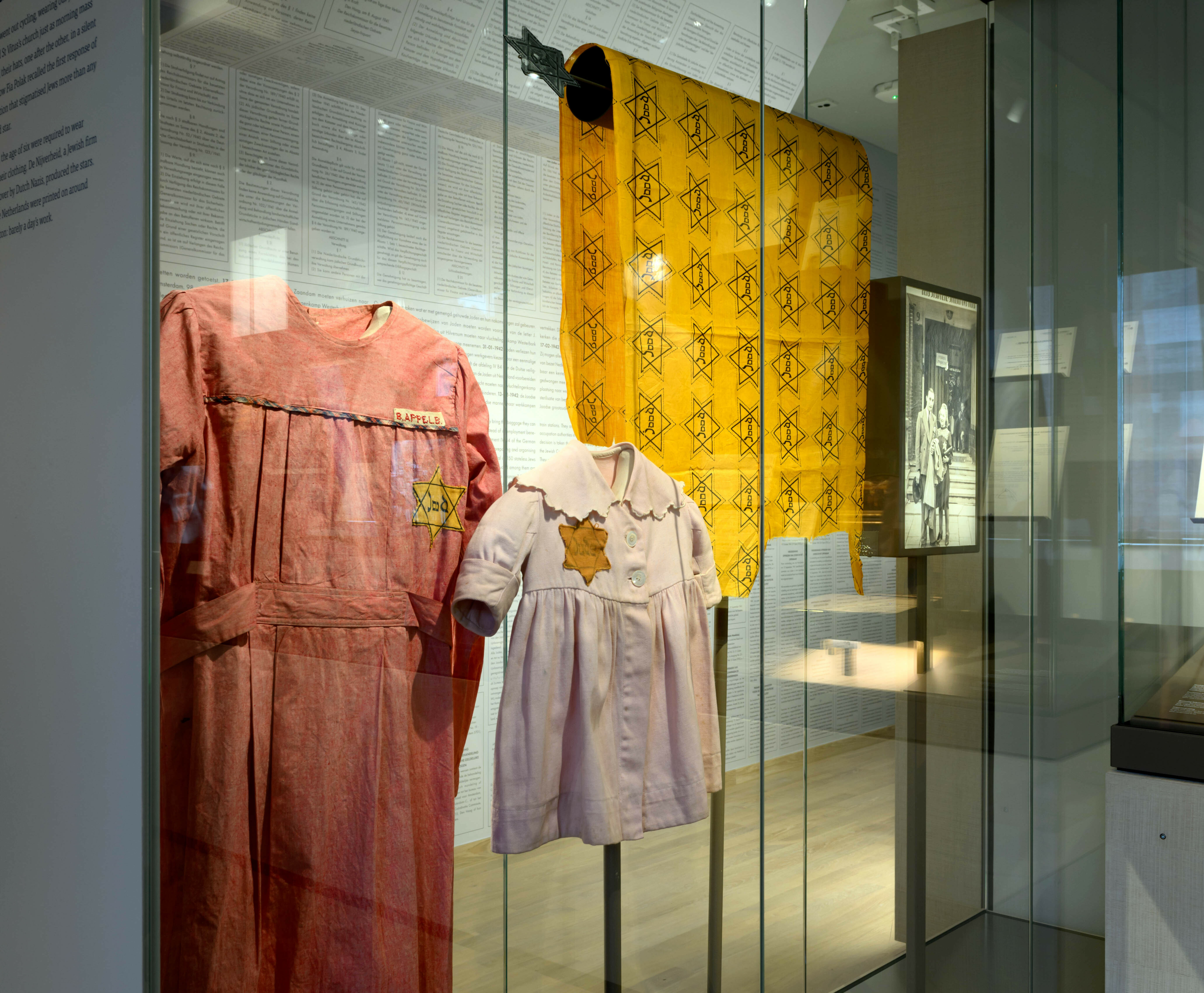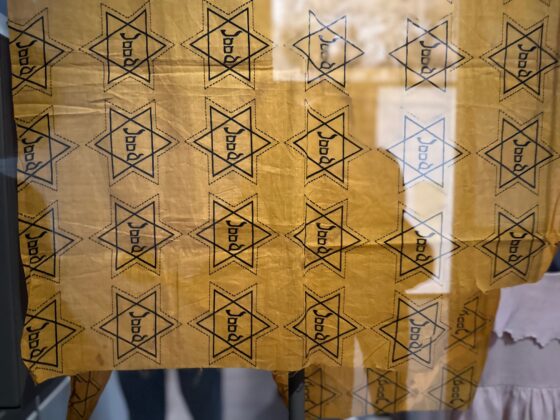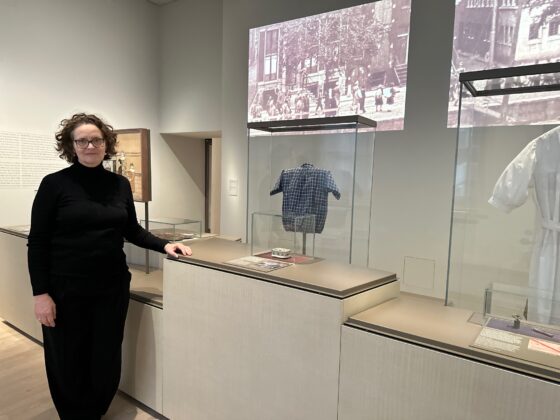The National Holocaust Museum and me: where past meets present
Lauren Comiteau
As Jews worldwide gather around the Seder table this week for Passover, recounting the biblical story of the Israelites’ escape from slavery in Egypt, Lauren Comiteau reflects on injustices past and present, adding a second helping of bitter herbs to her own Seder plate.
The Dutch National Holocaust Museum opened last month with much pomp and ceremony—and protest—all broadcast live on national television.
There was Dutch king Willem-Alexander wearing a yarmulke and talking about how Sobibor began in the Vondelpark with a sign reading “forbidden to Jews”; a Holocaust survivor and his great granddaughter, flanked by the king and Amsterdam mayor Femke Halsema, hanging a mezuzah on the entranceway to the new museum; and the controversial appearance of Israeli President Yitzhak Herzog, declaring “never again is now.”
Protestors outside held signs with the same slogan.
Never again is now—for seemingly everyone.
For Herzog, never again is now because “hatred and anti- Semitism are flourishing worldwide and we must fight it together.”
For the some 2,000 protestors taking issue with the appearance at the museum’s opening of the president of a wartime Israel that, according to Hamas officials, has killed more than 34,000 Palestinians and where the UN says famine is “imminent”—also broadcast live on television—is an affront to what the Netherlands stands for.
“The people from the Holocaust museum say we should not make things political,” said Yuval Gal from the Jewish anti-Zionist movement Erev Rav, which called for the demonstration. “But we can’t sit still while there is the threat of genocide, apartheid or occupation.”
“Separate things”
Eighty-one-year-old Fred van Vliet, one of the surviving babies from the Jewish creche adjacent to the building that now houses the country’s first national Holocaust museum, was at the ceremony. He called the demonstrations, which could be heard inside the Portuguese Synagogue throughout the ceremony, “regrettable”.
“There should not be protests on a day like today,” he said. “People should be able to separate things.”
But should we be able to? And do we even want to?
Annemiek Gringoud, head curator of the museum, says we should. This museum, she points out, was some 20-years in the making, and while the timing of its opening during the war in Gaza may be bitter, the museum is a historical record that can steer clear of current events.
“This is Dutch history. We didn’t make this museum for making a statement about Israel,” she says. In fact, she says it wasn’t made for Dutch Jews like herself, Jews like me from the wider diaspora or the small Jewish minority left in the Netherlands after three-quarters of the Dutch Jewish population were wiped out in the Holocaust, the highest proportion in western Europe.
“Jews are most welcome, of course. But this museum is for Dutch audiences and the public. We think people in the Netherlands should know this history and do something with it,” she says. “We are worried about how this war in the Middle East is polarizing Dutch society, but we very much work as a museum for the long term and think we can contribute against this polarization. We keep our focus on that horizon.”
The exhibitions
Gringoud walked me through the exhibits, including a jewellery box containing 6-year-old Jewish Esther’s bracelet whose extra links were never needed because her parents gave her cyanide early in the war.
There is a piece of fabric with neat rows of the yellow Stars of David Jews were forced to wear to mark themselves as Jood, or Jew. Gringoud tells me the country’s Jews were allowed only four stars per person, and they had to pay for them with cash and textile coupons. In the corner of the mass- produced fabric, one of the stars has been cut out.

“You can see it’s been used,” says Gringoud. “It was made in a small textile factory in Enschede, a former Jewish family business annexed by the Nazis. It took one full nightshift in 1942 to print enough Jewish stars for the entire Jewish population in the Netherlands…. It was a very profitable enterprise.”
We also walk through a room covered floor-to-ceiling with dated Nazi regulations against Jews (and Roma and Sinti, too)—the so-called “wallpaper of crimes”— that slowly eroded their rights and took away their citizenship step-by-incremental-step from the May 1940 Nazi invasion onwards.
“The occupiers immediately started dismantling the democratic and constitutional state,” says Gringoud. “They implemented new regulations that started placing the Jewish community of this country outside the law. They had no more rights until the summer of 1942, when the massive deportations from the Netherlands to the concentration and extermination camps started.”
This is the history she wants the public to see—how “regular” people went along with the regulations, ignored them or even collaborated with them. The Dutch have historically not been good at that. And Gringoud says early visitors to the museum have indeed found the wallpaper of crimes confronting.
“These measures were implemented by Dutch civil servants and administrators, even if they were ordered by the German occupiers,” she says. “Dutch volunteers were very much involved in perpetrating the same crimes as the Nazis. There were Jew hunters among the Dutch. If there’s anything we do beyond history, it’s that we make people more aware of themselves and be a critical citizen and not indifferent.”
First visitors
I visited the National Holocaust Museum the Monday after the opening ceremony, the first day visitors were welcome through its heavily secured doors. They arrived in a fairly steady stream, and the few visitors I spoke with were clearly moved by what they saw.
Rose (34) from Amsterdam was so emotional after visiting the exhibition that she could barely get a word out between her tears.
Ellen Rosenstein took her wheelchair-bound husband to see the museum on opening day. The 70-year-old born and raised Amsterdammer, who is Jewish, points to the Hollandsche Schouwburg across the street, telling me her father escaped over the roof of the former theatre that served as the last stop for tens of thousands of Dutch Jews before they were shipped to concentration camps.
“It’s a sad story,” she says of what happened to Holland’s Jews. “It would be nice if the museum wasn’t necessary to have here, but it is very necessary to have it here.”

Retiree Sien (67) from Middelburg says the museum does a good job showing why people do what they do, making choices between good and evil. “You just need simple measures, every day a little bit more, and then people are not seen as people anymore,” she says. “And we see it happening now in Gaza and Sudan and the US, what can happen if someone like Trump comes along. You see it everywhere. It’s good there were protests because it’s very important to see also what happens in Palestine and Israel, what Israel and Hamas do.”
The Occupation
When I was in the West Bank a decade ago on a Swedish NGO-organised trip to see the conflict from an international humanitarian law perspective, I witnessed some of the effects of occupation first-hand.
There were the roads only Israelis and us foreigners could travel on and the other ones open to Palestinians. There was our fixer who we could never take out to dinner because if she wasn’t back in Ramallah by the night-time curfew, she’d lose her right to work in Israel. There is one civilian justice system for Israeli citizens, another separate military court system for Palestinians.
When Gringoud talks about the rights of Jews in the Nazi-occupied Netherlands being slowly stripped away until they were non-citizens, I can’t help think of the Palestinians I met in the West Bank. I cannot see the museum in a historical vacuum. In fact, I’m wondering if the Netherlands’ newest museum will serve as a blueprint for the museums of current and future war crimes victims.
In my darker moments, it makes me wonder why museums bother documenting a past at all when nothing ever changes in the present. Walking through the museum’s exhibitions, I’m reminded that we humans never learn, except maybe what to expect. (And even then, add on two atrocities you never thought were possible. As in flying a plane full of people into a building full of people. For example.)
Never again is always.
“What do you want people who come to this museum to walk away with?” I asked Gringoud.
“I want people not to be indifferent,” she tells me. “I want people to think about what humans can do to other humans. And also, to determine what is their role in our society. To be caring. That’s what I want them to walk away with.”
Sounds very much like the present to me.
Thank you for donating to DutchNews.nl.
We could not provide the Dutch News service, and keep it free of charge, without the generous support of our readers. Your donations allow us to report on issues you tell us matter, and provide you with a summary of the most important Dutch news each day.
Make a donation